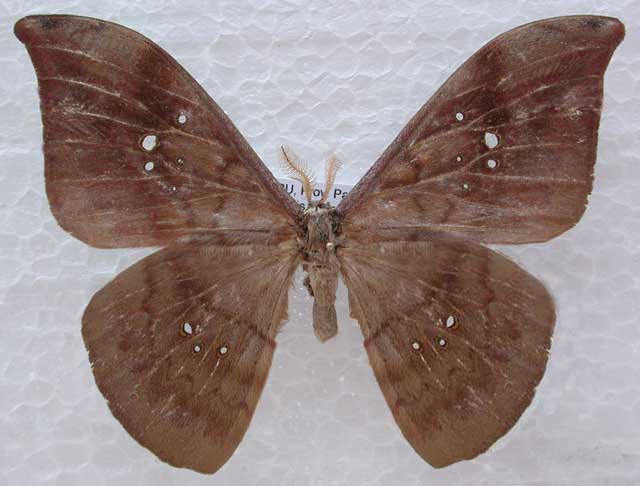Copaxa vanschaycki
Copaxa vanschaycki
koh-PAX-uhMvan-SHAKE-eye
Brechlin & Meister 2010

Copaxa vanschaycki male, Peru, courtesy of Eric van Schayck.
This site has been created by
Bill Oehlke at oehlkew@islandtelecom.com
Comments, suggestions and/or additional information are welcomed by Bill.
| TAXONOMY:
Superfamily: Bombycoidea, Latreille, 1802
Family: Saturniidae, Boisduval, [1837] 1834
Subfamily: Saturniinae, Boisduval, [1837] 1834
Tribe: Saturniini, Boisduval, 1837
Genus: Copaxa, Walker, 1855
| | MIDI MUSIC
"What.A.Wonderful.World"
copyright C. Odenkirk
MIDI CITY
ON.OFF
<bgsound src="world.mid" LOOP=FOREVER>
|
DISTRIBUTION:
Copaxa vanschaycki
(wingspan: males: 106mm; females: mm // forewing length: males: 54-57mm; females: ) flies in
Peru: San Martin; Amazonas; at elevations from 900-1800m.
Males exhibit two different colour forms: yellow with blackish grey suffusions surrounding the forewing cell as per image at top of page, and
light brown as per the image below, which could also be Copaxa madrediosiana or Copaxa satellita.

Copaxa madrediosiana or Copaxa vanschaycki or Copaxa satellita male,
Peru, courtesy of Eric van Schayck,
id and digital repair by Bill Oehlke.
Because of the placement of the inner column of three small hyaline cell spots, with the lowest one well below the cell, I favour either
Copaxa vanschaycki or Copaxa madrediosiana for the brown specimen directly above. There is very little to distinguish between the
two species, with C. madrediosiana being darker in the brown form, and the spots smaller in madrediosiana as per the image. There are other features
of the specimen, however, which suggest C. vanschaycki. I will place the image on both files.
FLIGHT TIMES AND PREFERRED FOOD PLANTS:
Copaxa
vanschaycki larvae probably feed upon avocado (Persea americana).
Most of the Copaxa brood continuously so I suspect
vanschaycki would be on the wing every month of the year. However, specimens have only been recorded thus far in December.
ECLOSION, SCENTING AND MATING:
Male Copaxa vanschaycki moths use highly developed antennae to locate
females by tracking the airbourne pheromone plume. The female releases this scent into the air via an organ extended
from the tip of the abdomen.
EGGS, LARVAE, COCOONS AND PUPAE:
It is hoped that this alphabetical listing followed by the common name of the anticipated foodplant will
prove useful. The list is not exhaustive. Experimenting with closely
related foodplants is worthwhile.
Persea americana .......
|
Avocado
|
The species name is honourific for Eric Van Schayck.
Use your browser "Back" button to return to the previous page.
Return to Copaxa Index
Goto South American Saturniidae Directory
Goto Main Saturniidae Index

